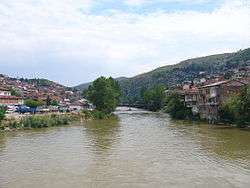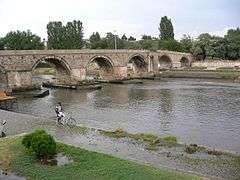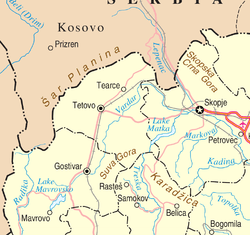Vardar
| Vardar (Вардар), Axios (Αξιός) | |
|---|---|
 Vardar in Veles | |
| Countries | Republic of Macedonia, Greece |
| Physical characteristics | |
| Main source | Vrutok, near Gostivar |
| River mouth |
Aegean Sea, near Thessaloniki 40°30′27″N 22°43′3″E / 40.50750°N 22.71750°ECoordinates: 40°30′27″N 22°43′3″E / 40.50750°N 22.71750°E |
| Length | 388 km (241 mi) |
The Vardar (Macedonian: ![]()
Etymology
The etymology of the word is unclear. However most probably, the origin of the name Vardar derives Bardários from Thracian, from Proto-Indo-European (PIE) *(s)wordo-wori- 'black water'.[1][2] It can be considered a translation or similar meaning of Axios, which itself is Thracian for 'not-shining' from PIE *n.-sk(e)i (cf. Avestan axšaēna 'dark-coloured'),[3] and found in another name at the mouth of the Danube, Axíopa "dark water", renamed in Slavic Cernavodă 'black water'.[4] The name Bardários (Βαρδάριος) was sometimes used by the Ancient Greeks in the 3rd Century BCE. The same name was widely used in the Byzantine era.[4] The word may ultimately be derived from the PIE root *werǵ-, which is also the source of the English word "to work." Another theory by the german philologist and linguist, Hans Krahe suggested that name Vardar derived from the vord "Bardhar" which in the albanian language "Bardhe" would mean white.[5]
Its Greek name, Axios (Αξιός), is mentioned by Homer (Il. 21.141, Il. 2.849)[6] as the home of the Paeonians allies of Troy.
Geography

The river rises at Vrutok, a few kilometers north of Gostivar in the Republic of Macedonia. It passes through Gostivar, Skopje and into Veles, crosses the Greek border near Gevgelija, Polykastro and Axioupoli ("town on the Axiós"), before emptying into the Aegean Sea in Central Macedonia, west of Thessaloniki in northern Greece.
The Vardar basin comprises two-thirds of the territory of the Republic of Macedonia. The valley features fertile lands in the Polog region, around Gevgelija and in the Thessaloniki regional unit. The river is surrounded by mountains elsewhere. The superhighways Greek National Road 1 in Greece and M1 and E75 run within the valley along the river's entire length to near Skopje.
The river was very famous during the Ottoman Empire and remains so in modern-day Turkey as the inspiration for many folk songs, of which the most famous is Vardar Ovasi. It has also been depicted on the coat of arms of Skopje, which in turn is incorporated in the city's flag.[7]
Project to Construct the Danube-Vardar-Aegean Canal
The Project to Construct the Danube-Morava-Vardar-Aegean Canal has been a dream for a long time.[8] Le Figaro published a project of Athens and Belgrade on 28.08.2017. The Greek-Serbian proposal made in Peking is Pharaonic: 651 km. A project worth 17 billion.[9]
Vardaris wind
The Vardaris or Vardarec is a powerful prevailing northerly ravine wind which blows across the river valley in Greek Macedonia as well as in the Republic of Macedonia. At first it descends along the "canal" of the Vardar valley, usually as a breeze. When it encounters the high mountains that separate Greece from the Republic of Macedonia, it descends the other side, gathering a tremendous momentum and bringing cold conditions to the city of Thessaloniki and the Axios delta. Somewhat similar to the mistral wind of France, it occurs when atmospheric pressure over eastern Europe is higher than over the Aegean Sea, as is often the case in winter.
Gallery
 Map of northwestern Republic of Macedonia including the source of the Vardar
Map of northwestern Republic of Macedonia including the source of the Vardar Axios/Vardar river map
Axios/Vardar river map Veles Gorge
Veles Gorge- River Vardar near Gradsko
- River Vardar near Gradsko (2)
 Vardar (Axios) river in Greece.
Vardar (Axios) river in Greece. Longitudinal hidrographic profile of the flow of river Vardar
Longitudinal hidrographic profile of the flow of river Vardar
See also
References
- ↑ Orel, Vladimir. A Handbook of Germanic Etymology. Leiden, Netherlands: Brill, 2003: 392.
- ↑ Mallory, J.P. and D.Q. Adams. Encyclopedia of Indo-European Culture. London: Fitzroy and Dearborn, 1997: 147
- ↑ Mallory, J.P. and D.Q. Adams. Encyclopedia of Indo-European Culture. London: Fitzroy and Dearborn, 1997, p. 146
- 1 2 Katičic', Radoslav. Ancient Languages of the Balkans. Paris: Mouton, 1976: 149
- ↑ NJEKOMB. "Lumi Vardar apo, në shqip, lumi Bardhar! | Shqipëria e Bashkuar". shqiperia.njekomb.com. Retrieved 2018-06-26.
- ↑ Axios, Georg Autenrieth, A Homeric Dictionary, at Perseus
- ↑ Official portal of the city of Skopje: City symbols. – Retrieved on 13 May 2009.
- ↑ The Project to Construct the Danube-Aegean Canal(2013)
- ↑ The Greek-Serbian proposal made in Peking
External links
| Wikimedia Commons has media related to Vardar. |
- Proceedings of the 1st Axios Catchment Consortium Meeting by the European Commission - DG Research.
- PIM "Ivan Milutinović", Belgrade, Serbia; Morava - Vardar (Axios) Navigation Route (About 1,200 km shorter route (three days shorter time of navigation) from Belgrade to Port of Thessaloniki than across Danube, Black Sea and Aegean Sea. Electric power production, improvement of water quality and regulation of flooding wave.)
- Morava - Vardar (Axios) Navigation Route map
- Hydropower and navigation system "Morava" (Concepts of regulation of rivers Great Morava and South Morava for navigation and hydropower production.)